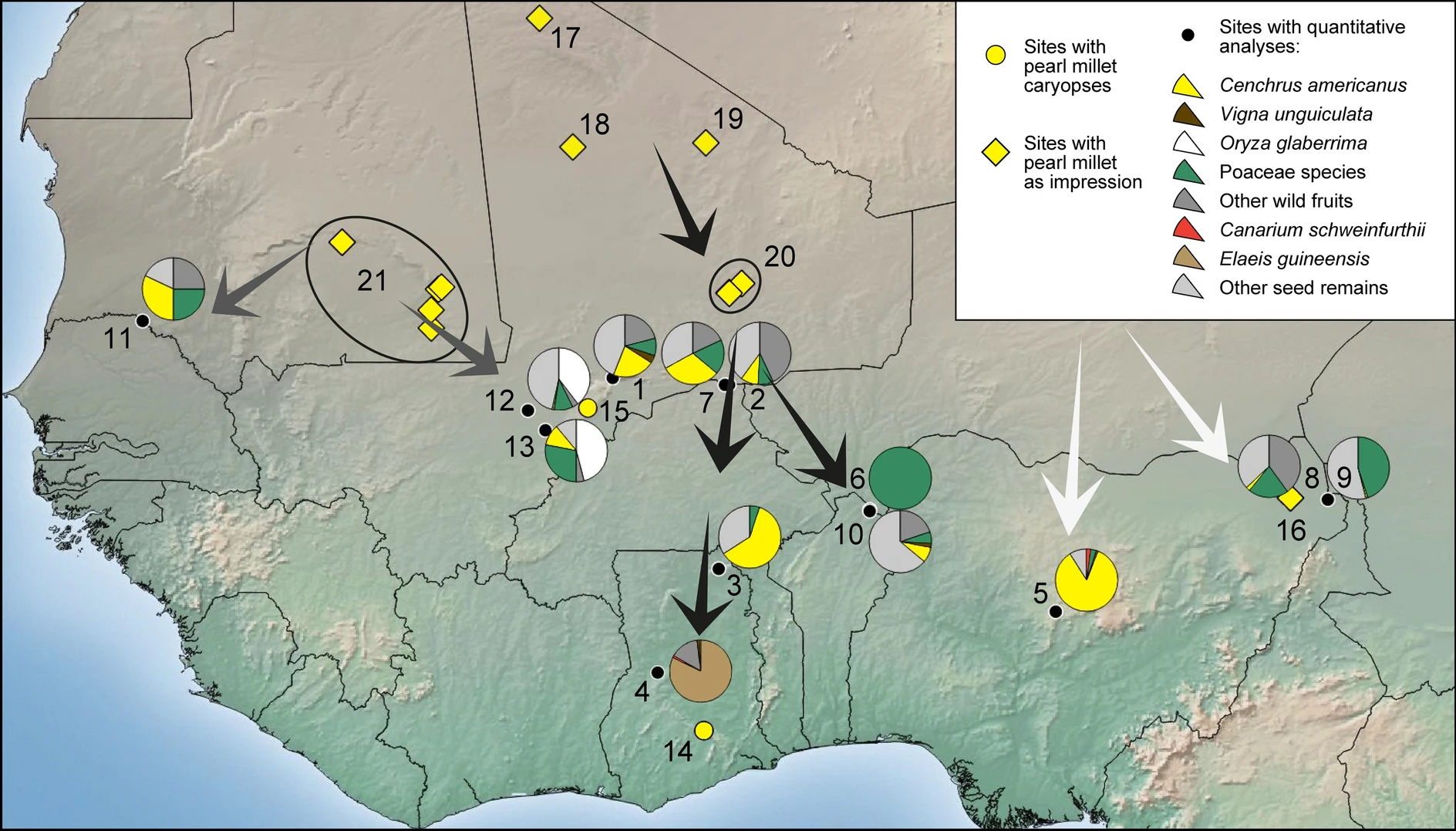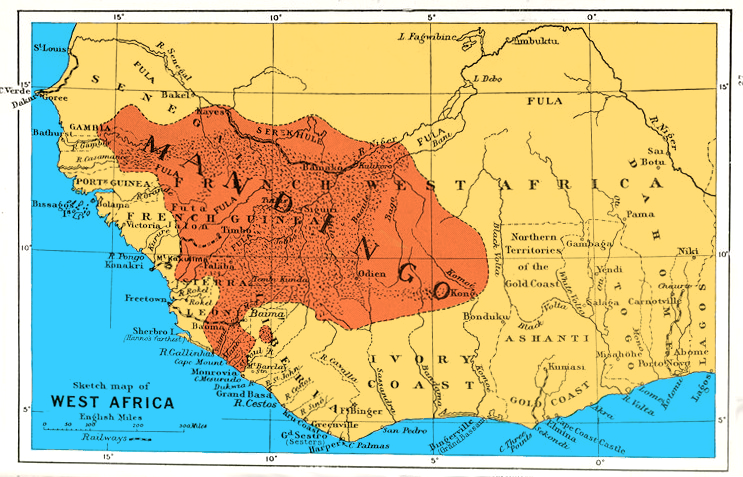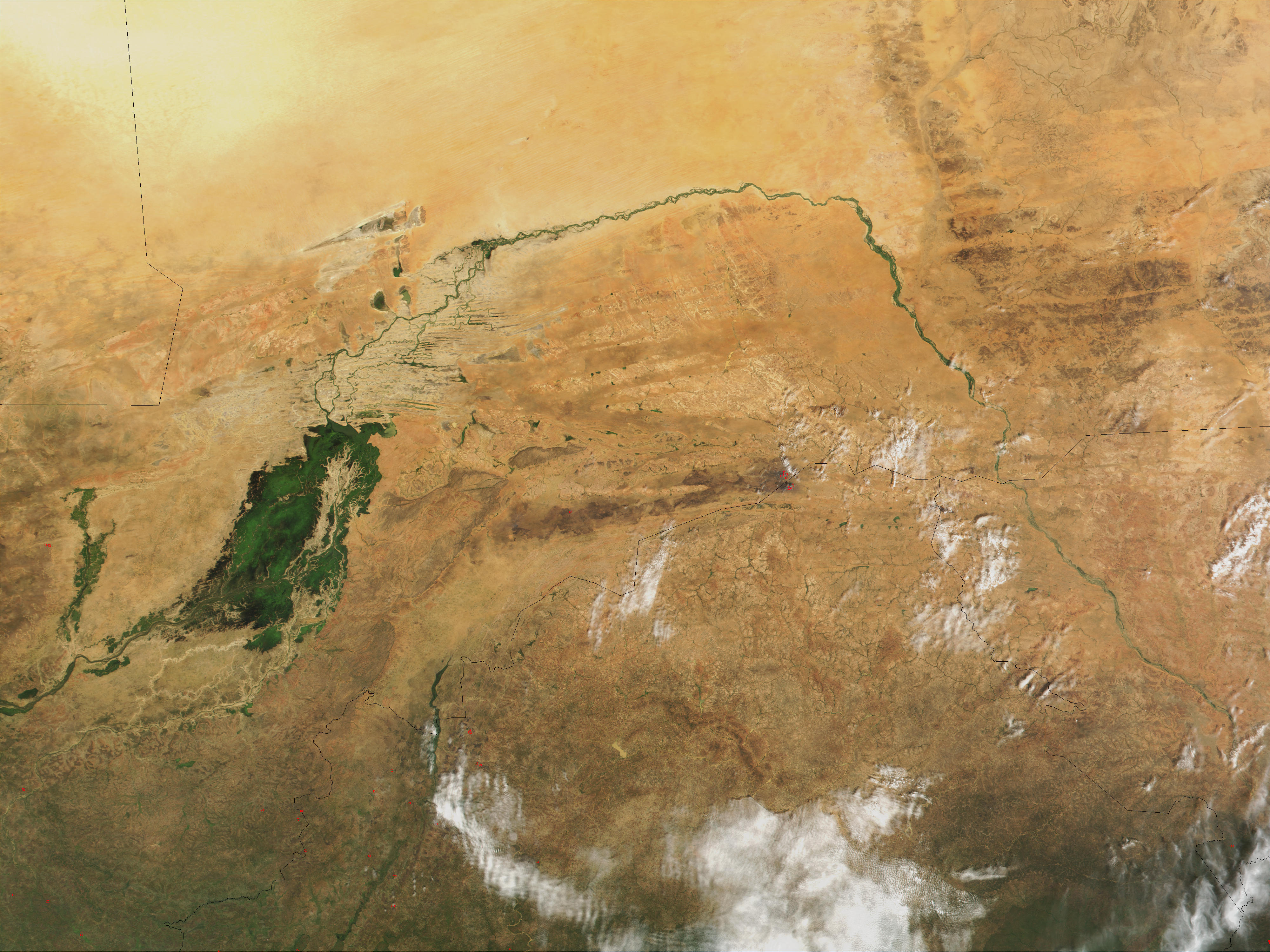|
Bambuk
Bambouk (sometimes Bambuk or Bambuhu) is a traditional name for the territory in eastern Senegal and western Mali, encompassing the Bambouk Mountains on its eastern edge, the valley of the Faleme River and the hilly country to the east of the river valley. It was a formally described district in French Sudan, but in 1895, the border between French Sudan and Senegal was moved to the Faleme River, placing the western portion of the district within Senegal. The term is still used to designate the region, but there is no formal administrative area with that name. Bambouk is primarily home to the Malinké people, and a distinctive dialect of the Maninkakan language is spoken there. History According to Martin Meredith, the Carthaginians used Berber nomads to establish a packhorse trade route across the Sahara between Lixus and "the goldfields of Bambuk in the Senegal River valley roughly 6th century BC to 2nd century BC." The Diakhanke established Diakha-ba and became Mu ... [...More Info...] [...Related Items...] OR: [Wikipedia] [Google] [Baidu] |
The Mali Empire
The Mali Empire ( Manding: ''Mandé''Ki-Zerbo, Joseph: ''UNESCO General History of Africa, Vol. IV, Abridged Edition: Africa from the Twelfth to the Sixteenth Century'', p. 57. University of California Press, 1997. or ''Manden Duguba''; ) was an empire in West Africa from 1226 to 1610. The empire was founded by Sundiata Keita () and became renowned for the wealth of its rulers, especially Mansa Musa (Musa Keita). At its peak, Mali was the largest empire in West Africa, widely influencing the culture of the region through the spread of its language, laws, and customs. The empire began as a small Mandinka kingdom at the upper reaches of the Niger River, centered around the Manding region. It began to develop during the 11th and 12th centuries as the Ghana Empire, or Wagadu, declined and trade epicentres shifted southward. The history of the Mali Empire before the 13th century is unclear, as there are conflicting and imprecise accounts by both Arab chroniclers and oral trad ... [...More Info...] [...Related Items...] OR: [Wikipedia] [Google] [Baidu] |
Bondu
Bundu (also Bondu, Bondou and Boundou) was a state in West Africa existing from the late 17th century until it became a French protectorate dependent on the colony of Senegal. It lay between the Falémé River and the upper course of the Gambia River, that is between 13 and 15 N., and 12 and 13 W. Description The country is an elevated plateau, with hills in the southern and central parts. These are generally unproductive, and covered with stunted wood; but the lower country is fertile, and finely clothed with the baobab, the tamarind and various valuable fruit-trees. Bondu is traversed by torrents, which flow rapidly during the rains but are empty in the dry season. This cites A. Rançon, ''Le Bondou: étude de géographie et d'histoire soudaniennes de 1681 à nos jours'' (Bordeaux, 1894). The name 'Bundu' means ' well' in Pulaar. History Early History Bundu in the 17th century was a sparsely populated part of the kingdom of Gajaaga inhabited mostly by Pulaar communities ... [...More Info...] [...Related Items...] OR: [Wikipedia] [Google] [Baidu] |
Bundu (state)
Bundu (also Bondu, Bondou and Boundou) was a state in West Africa existing from the late 17th century until it became a French protectorate dependent on the colony of Senegal. It lay between the Falémé River and the upper course of the Gambia River, that is between 13 and 15 N., and 12 and 13 W. Description The country is an elevated plateau, with hills in the southern and central parts. These are generally unproductive, and covered with stunted wood; but the lower country is fertile, and finely clothed with the baobab, the tamarind and various valuable fruit-trees. Bondu is traversed by torrents, which flow rapidly during the rains but are empty in the dry season. This cites A. Rançon, ''Le Bondou: étude de géographie et d'histoire soudaniennes de 1681 à nos jours'' (Bordeaux, 1894). The name 'Bundu' means 'well' in Pulaar. History Early History Bundu in the 17th century was a sparsely populated part of the kingdom of Gajaaga inhabited mostly by Pulaar communities but ... [...More Info...] [...Related Items...] OR: [Wikipedia] [Google] [Baidu] |
Mali Empire
The Mali Empire (Manding languages, Manding: ''Mandé''Ki-Zerbo, Joseph: ''UNESCO General History of Africa, Vol. IV, Abridged Edition: Africa from the Twelfth to the Sixteenth Century'', p. 57. University of California Press, 1997. or ''Manden Duguba''; ) was an empire in West Africa from 1226 to 1610. The empire was founded by Sundiata Keita () and became renowned for the wealth of its rulers, especially Mansa Musa (Musa Keita). At its peak, Mali was the largest empire in West Africa, widely influencing the culture of the region through the spread of Manding languages, its language, laws, and customs. The empire began as a small Mandinka people, Mandinka kingdom at the upper reaches of the Niger River, centered around the Manding region. It began to develop during the 11th and 12th centuries as the Ghana Empire, or Wagadu, declined and trade epicentres shifted southward. The Pre-imperial Mali, history of the Mali Empire before the 13th century is unclear, as there are conflict ... [...More Info...] [...Related Items...] OR: [Wikipedia] [Google] [Baidu] |
Senegal River
The Senegal River ( or "Senegal" - compound of the Serer term "Seen" or "Sene" or "Sen" (from Roog Seen, Supreme Deity in Serer religion) and "O Gal" (meaning "body of water")); , , , ) is a river in West Africa; much of its length marks part of the border between Senegal and Mauritania. It has a drainage basin of , a mean flow of , and an annual discharge of . Important tributaries are the Falémé River, Karakoro River, and the Gorgol River. The river divides into two branches once it passes Kaédi. The left branch, called the Doué, runs parallel to the main river to the north. After the two branches rejoin a few kilometers downstream of Podor. In 1972 Mali, Mauritania and Senegal founded the Organisation pour la mise en valeur du fleuve Sénégal (OMVS) to manage the river basin. Guinea joined in 2005. , only very limited use was made of the river for the transportation of goods and passengers. The OMVS have looked at the feasibility of creating a navigable ... [...More Info...] [...Related Items...] OR: [Wikipedia] [Google] [Baidu] |
Akan People
The Akan () people are a kwa languages, Kwa group living primarily in present-day Ghana and in parts of Ivory Coast and Togo in West Africa. The Akan speak languages within the Central Tano languages, Central Tano branch of the Potou–Tano languages, Potou–Tano subfamily of the Niger–Congo languages, Niger–Congo family.''Languages of the Akan Area: Papers in Western Kwa Linguistics and on the Linguistic Geography of the Area of Ancient''. Isaac K. Chinebuah, H. Max J. Trutenau, Linguistic Circle of Accra, Basler Afrika Bibliographien, 1976, pp. 168. Subgroups of the Akan people include: the Adansi, Agona, Akuapem people, Akuapem, Akwamu, Akyem, Anyi people, Anyi, Ashanti people, Asante, Baoulé people, Baoulé, Bono people, Bono, Chakosi people, Chakosi, Fante people, Fante, Kwahu, Sefwi people, Sefwi, Wassa, Ahanta people, Ahanta, Denkyira and Nzema people, Nzema, among others. The Akan subgroups all have cultural attributes in common; most notably the tracing of royal m ... [...More Info...] [...Related Items...] OR: [Wikipedia] [Google] [Baidu] |
Jakhanke People
The Jakhanke -- also spelled Jahanka, Jahanke, Jahanque, Jahonque, Diakkanke, Diakhanga, Diakhango, Dyakanke, Diakhanké, Diakanké, or Diakhankesare -- are a Manding-speaking ethnic group in the Senegambia region, often classified as a subgroup of the larger Soninke. The Jakhanke have historically constituted a specialized caste of professional Muslim clerics (''ulema'') and educators.Lamin O. Sanneh. ''The Jakhanke: The history of an Islamic clerical people of the Senegambia''. London (1979) They are centered on one larger group in Guinea, with smaller populations in the eastern region of The Gambia, Senegal, and in Mali near the Guinean border. Although generally considered a branch of the Soninke (also known as Serahule, Serakhulle or Sarakollé), their language is closer to Western Manding languages such as Mandinka. Since the fifteenth century the Jakhanke clerical communities have constituted an integral part of the region and have exercised a high level of economic and ... [...More Info...] [...Related Items...] OR: [Wikipedia] [Google] [Baidu] |
Malinké
The Mandinka or Malinke are a West African ethnic group primarily found in southern Mali, The Gambia, southern Senegal and eastern Guinea. Numbering about 11 million, they are the largest subgroup of the Mandé peoples and one of the largest ethnolinguistic groups in Africa. They speak the Manding languages in the Mande language family, which are a ''lingua franca'' in much of West Africa. They are predominantly subsistence farmers and live in rural villages. Their largest urban center is Bamako, the capital of Mali. The Mandinka are the descendants of the Mali Empire, which rose to power in the 13th century under the rule of king Sundiata Keita, who founded an empire that would go on to span a large part of West Africa. They migrated west from the Niger River in search of better agricultural lands and more opportunities for conquest. Nowadays, the Mandinka inhabit the West Sudanian savanna region extending from The Gambia and the Casamance region in Senegal, Mali, Guinea and ... [...More Info...] [...Related Items...] OR: [Wikipedia] [Google] [Baidu] |
Khasso
Khasso or Xaaso is a region and former West African kingdom of the 17th to 19th centuries, occupying territory in what is today the Kayes Region of Mali. From the 17th to 19th centuries, its capital was at Medina until its fall. Khasso straddles both banks of the upper Senegal River roughly from Kayes to Bafoulabe, in a strip at most 60 km wide. It is located at the transition point between the mountains to the south and the arid plans to the north, and between the Senegambia region and the Niger river valley. History Over two thousand years ago, Khasso was populated by the Serer. The Khassonke people, however, were originally FulasIn ; in . who immigrated to the area and integrated with the local Malinké and Soninké populations. Initially oppressed by their hosts, the Fula revolted and in 1681 under the leadership of Yamadou Hawa they won their independence in battle at Toumbifara, near Bafoulabe. They elected Séga Doua (r. 1681 - 1725), Yamadou's son, as the first ' ... [...More Info...] [...Related Items...] OR: [Wikipedia] [Google] [Baidu] |
Alluvial Gold
Placer mining () is the mining of stream bed deposits for minerals. This may be done by open-pit mining or by various surface excavating equipment or tunneling equipment. Placer mining is frequently used for precious metal deposits (particularly gold) and gemstones, both of which are often found in alluvial deposits—deposits of sand and gravel in modern or ancient stream beds, or occasionally glacial deposits. The metal or gemstones, having been moved by stream flow from an original source such as a vein, are typically only a minuscule portion of the total deposit. Since gems and heavy metals like gold are considerably denser than sand, they tend to accumulate at the base of placer deposits. Placer deposits can be as young as a few years old, such as the Canadian Queen Charlotte beach gold placer deposits, or billions of years old like the Elliot Lake uranium paleoplacer within the Huronian Supergroup in Canada. The containing material in an alluvial placer mine may be too lo ... [...More Info...] [...Related Items...] OR: [Wikipedia] [Google] [Baidu] |
Soninke Wangara
The Wangara (also known as Wakore, Wankori, Ouankri, Wangarawa) are a diaspora community of ethnic Soninke origin who served as specialized long-distance merchants throughout West Africa, particularly in trans-Saharan trade. Originating from the Ghana Empire, over time the Wangara became integrated into numerous other communities and ethnic groups, particularly in Timbuktu, Agadez, Kano, Gao, Salaga, Kong, Bissa, Kankan, Fouta Jallon, Djenné as well as Bambouk, Bure, Lobi, and (to a lesser degree) Bono goldfields and Borgu. They were practicing Muslims who helped spread the religion widely and served as clerics, political advisors, healers and marabouts, often following the Suwarian Tradition. The term 'Wangara' is sometimes used interchangeably to refer to the Jakhanke or Dyula people, who are also diasporic traders and Islamic clerics of Mande origin. History The Wangara, like the Soninke of which they are a part, are descendants from migrants out of the once-ferti ... [...More Info...] [...Related Items...] OR: [Wikipedia] [Google] [Baidu] |
Upper Niger
The Niger River ( ; ) is the main river of West Africa, extending about . Its drainage basin is in area. Its source is in the Guinea Highlands in south-eastern Guinea near the Sierra Leone border. It runs in a crescent shape through Mali, Niger, on the border with Benin and then through Nigeria, discharging through a massive delta, known as the Niger Delta, into the Gulf of Guinea in the Atlantic Ocean. The Niger is the third-longest river in Africa, exceeded by the Nile and the Congo River. Its main tributary is the Benue River. Etymology The Niger has different names in the different languages of the region: * Fula: ''Maayo Jaaliba'' * Manding: ''Jeliba'' or ''Joliba'' "great river" * Tuareg: ''Eġərəw n-Igərǝwăn'' "river of rivers" * Songhay: ''Isa'' "the river" * Zarma: ''Isa Beeri'' "great river" * Hausa: ''Kwara'' * Nupe: ''Èdù'' * Yoruba: ''Ọya'' "named after the Yoruba goddess Ọya, who is believed to embody the river" * Igbo: ''Orimiri'' or ''O ... [...More Info...] [...Related Items...] OR: [Wikipedia] [Google] [Baidu] |







